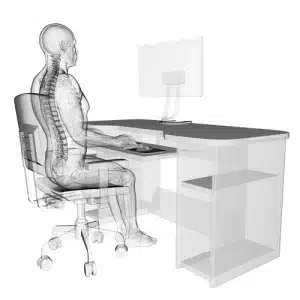Ergonomics is the design of our environment with the goal of making it more efficient and comfortable. Given that we spend two-thirds of our time at the workplace and in bed, it makes sense to discuss how we can improve these environments to lessen back pain. Media outlets run stories on how back pain can be lessened by sitting less, repositioning our computer screens, and changing our office chairs. If our workplace can be the cause of back pain, then surely we can modify our workplace to prevent back pain, right?
Actually, no. While altering our environments can help, it’s only a part of the story.
According to medical studies, our efforts to alter the workplace to avoid back pain have been scrutinized by evidence-based medicine and found to be largely ineffective. The reason is because the causes of back pain are so varied person to person. And for many people, back pain is just part of life and not preventable — just as you can’t prevent a headache or a common cold.
Bottom line: Back pain is a mixed bag — arising from several different underlying pathologies.
The relationship between work and back pain has a long history, and when back pain was covered by worker’s compensation insurance, it helped transition back pain from being perceived as part of life to an injury requiring treatment. For anyone who experiences back pain, there are things you can do to lessen your back pain.
Strengthen your core. The optimal intervention is to partake in a regular workout that results in core strengthening and emphasizes the part of your core that is behind you or hidden. This can alter the form with which you sit. It can actually change your back. This will strengthen and shorten the weak gluteal muscles.
Use kettlebells. Perhaps, the best way to strengthen your hidden core is with the use of kettlebells. These weights with a handle force you to engage your posterior chain of muscles when doing the associated exercises — particularly the gluteal muscles that are often weakened by excessive sitting.
Use good technique. The kettlebell is the proverbial double-edged sword, however. Its tremendous potential is coupled with an inherent risk. Good technique is essential. Learn and then utilize the remarkable kettlebell swing to limit your pain at work.
Still optimize your work environment.This is not to say that we should forget about trying to optimize our work environment. Little changes in computer height or type of chair may pay dividends in terms of comfort.
Don’t sit too long. According to many studies, there is evidence that sitting for long periods of time can be detrimental to our back and our health. Czech neurologist Vladimir Jandadescribed a lower cross syndrome marked by weak gluteal muscles and tight ileopsoas muscles. This is often the result of too much sitting and can result in repeated episodes of back pain.
Make standing up a habit. Getting up from a sitting position every 15 minutes as a habit will certainly help, but it’s not enough.
In addition to back strengthening, there is another intervention that you can make at work that can reduce back pain, and it’s not what you would expect. Turns out that job satisfaction is a powerful antidote to back pain at work. If you want to avoid chronic or recurrent back pain, find a way to enjoy your job — or find a job that you enjoy. This is an over-simplification, and easier said than done of course, but the point is that only you can make things better.
Looking for an ergonomic overhaul, to do the job for you, will leave you disappointed.
Source: www.huffingtonpost.com; Patrick Roth, MD; December 5, 2014.
For a FREE ERGONOMIC Evaluation of your office please contact our office. We will gladly come to your office!
Your Opinion Matters to Us!
Tell us if you found this article useful or what are other health issues that are interesting to you. Send us your health questions and we will try to answer them as soon as possible.



